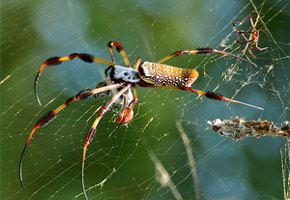

A Thematic Project linked to BIOTA-FAPESP sheds light on the molecular structure of hundreds of toxins produced by spiders, wasps and other arthropods
A Thematic Project linked to BIOTA-FAPESP sheds light on the molecular structure of hundreds of toxins produced by spiders, wasps and other arthropods.
A Thematic Project linked to BIOTA-FAPESP sheds light on the molecular structure of hundreds of toxins produced by spiders, wasps and other arthropods.

A Thematic Project linked to BIOTA-FAPESP sheds light on the molecular structure of hundreds of toxins produced by spiders, wasps and other arthropods
By Fábio de Castro
Agência FAPESP – The toxins produced by venomous animals contain compounds that can be used in the development of a broad array of drugs and insecticides. However, in order for this to be possible, scientists must identify the compounds of interest, uncover their molecular structures, synthesize the molecules in the laboratory, and finally, conduct clinical tests.
For almost four years, a group of researchers have been dedicated to identifying and determining the molecular structures of roughly 200 peptides and proteins, in addition to 140 small molecules found in the venoms of different groups of spiders, wasps and other venomous arthropods from Brazil.
Conducted under the auspices of BIOTA-FAPESP, the Thematic Project “Searching for lead compounds for rational development of new drugs and pesticides through bioprospecting in Brazilian arthropods,” financed by FAPESP, was coordinated by Mario Sergio Palma, professor of the Universidade Estadual Paulista (Unesp) Biosciences Institute in Rio Claro (SP).
According to Palma, in addition to searching for new molecules, the scientists involved with the project conducted in-depth studies of the mechanisms of action of the toxins and gained experience in peptide and small molecule synthesis techniques.
“In addition to the extremely positive results of the study, the project allowed the creation of a peptide synthesis unit, produced 10 doctoral theses and 13 master’s dissertations and involved the participation of 6 post-doctoral students and 14 scientific initiation scholars,” he said in an interview with Agência FAPESP.
According to Palma, who holds a degree in chemistry, the work conducted by the group was essentially multidisciplinary and required the continuous establishment of partnerships with researchers in disciplines such as physiology and pharmacology. Although it involved only two permanent groups – Unesp in Rio Claro and Rio Preto – and four senior researchers, the group created collaborations in several areas and at diverse institutions.
“All the infrastructure generated by the Thematic Project – which allowed us to perfect structure analysis techniques and mass spectrometry – prompted the consolidation of our laboratories. During four years of the project, researchers at 63 institutions used our facilities, greatly increasing the number of publications related to our work,” Palma said.
The Thematic Project has two main foci: macromolecules, i.e., biopeptides and proteins, which have applications in the chemical and pharmaceutical industries, and small molecules. The team was split between these two foci and worked with different groups of venomous arthropods, including spiders, wasps, bees and ants.
“We were basically looking for drugs that act as neurotoxins. When you understand the structures and the actions of these substances, it is possible to make small modifications that enable them to act as neuroprotectors,” explains Palma.
Somewhere during the course of evolution, the structure of toxins evolved to adapt to the structure of the cells of animals targeted for attack or defense responses. Therefore, to understand a toxin, it is necessary to understand both its composition and the whole context in which it functions.
“For example, we work with two types of spiders: web-builders and wandering spiders, which live on the ground and hunt. The compositions of the venoms in each of these groups are very different because they are used for different purposes and distinct strategies,” says Palma.
The toxins of spiders that live far off the ground contain few proteins and peptides, but are full of small organic molecules that are similar to plant toxins. Spiders of the genus Nephila, which make enormous yellowish and gold webs, were the first targets of these studies.
“The sticky droplets on the nephilid’s web serve to capture small insects and also to lubricate the web and make it more flexible. They are composed of lipid vesicles that are filled with toxins,” he explains.
The scientists found that these lipids react with the exoskeletons of insects caught by the web, removing the wax that protects the insect and putting it in contact with neurotoxins, paralyzing the animal.
“These substances are extremely powerful insecticides. Some of the most interesting molecules we found are alkaloids taken from spiders and their prey, which sequester alkaloids from plants. Once a spider obtains the alkaloid, it modifies its structure, producing neurotoxins,” explains Palma.
Spiders only consume fresh protein, which is why they do not kill their prey. Instead, they must inject paralyzing venom into insects, saving them for moments of hunger. Furthermore, spiders produce different toxins according to the time of year, always producing poisons tailored to the type of prey available.
“We observed that the toxins used to provoke paralysis contain many different chemical structures. In this group of spiders, we solved the structures of 106 molecules,” explained the coordinator of the project.
Three of the toxins discovered, which cause transitory paralysis, proved to be especially interesting when tested on the nervous systems of rats and mice.
“We tested these three drugs in epilepsy models and discovered that they have promising antiepileptic effects. An article on the study was recently published in the magazine Brain Research,” Palma confirmed.
Republish
The Agency FAPESP licenses news via Creative Commons (CC-BY-NC-ND) so that they can be republished free of charge and in a simple way by other digital or printed vehicles. Agência FAPESP must be credited as the source of the content being republished and the name of the reporter (if any) must be attributed. Using the HMTL button below allows compliance with these rules, detailed in Digital Republishing Policy FAPESP.




